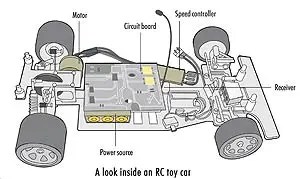How does a radio controlled car work?


A radio controlled car, also known as an RC car or remote control car, is a popular toy and hobby for people of all ages. These miniature vehicles are controlled remotely using a handheld transmitter, allowing the user to steer, accelerate, and brake the car from a distance. But have you ever wondered how exactly an RC car works? In this article, we will delve into the fascinating world of RC car technology, exploring the mechanics, parts, and components that make these miniature vehicles come to life.
RC Car Mechanics
At the heart of every RC car is a complex system of mechanics that work together to provide motion and control. Let’s take a closer look at the key components that make an RC car work:
1. RC Car Motor
The motor is the powerhouse of an RC car, responsible for generating the necessary torque and speed to propel the vehicle forward. Most RC cars use electric motors, which can be brushed or brushless. Brushed motors are more common in entry-level models, while brushless motors offer higher performance and efficiency. These motors are powered by a battery pack, which we will discuss in more detail later.
2. RC Car Transmission
The transmission in an RC car is responsible for transferring power from the motor to the wheels. It consists of gears and differentials that allow the wheels to rotate at different speeds, enabling smooth turns and improved traction. The transmission can be either a single-speed or a multi-speed system, depending on the complexity and performance of the RC car.
3. RC Car Suspension
Just like full-size cars, RC cars also feature suspension systems to absorb shocks and bumps. The suspension consists of springs and dampers that help maintain stability and control while driving over uneven terrain. High-end RC cars often have adjustable suspension systems, allowing users to fine-tune the car’s handling characteristics.
4. RC Car Tires
The tires of an RC car play a crucial role in its performance. They provide traction and grip, allowing the car to accelerate, brake, and corner effectively. RC car tires come in various tread patterns and compounds, each designed for specific surfaces and conditions. Off-road RC cars typically have larger, knobby tires for better traction on dirt and grass, while on-road RC cars feature slick tires for maximum grip on smooth surfaces.
RC Car Electronics
In addition to the mechanical components, RC cars also rely on a range of electronic devices to function properly. These include:
1. RC Car Battery
The battery is the primary source of power for an RC car. Most RC cars use rechargeable batteries, such as lithium-ion or nickel-metal hydride (NiMH) packs. The battery’s capacity and voltage determine the runtime and performance of the RC car. Higher capacity batteries offer longer runtimes, while higher voltage batteries deliver more power and speed.
2. RC Car Transmitter
The transmitter is the handheld device that the user holds to control the RC car. It sends signals to the car’s receiver, instructing it to perform specific actions such as steering and accelerating. The transmitter operates on a specific frequency, typically 2.4 GHz, to ensure reliable and interference-free communication with the RC car.
3. RC Car Receiver
The receiver is installed in the RC car and receives signals from the transmitter. It decodes these signals and sends corresponding commands to the car’s motor, steering servo, and other electronic components. The receiver is connected to the car’s battery and motor, allowing it to control their operation based on the user’s inputs.
RC Car Speed and Range
The speed and range of an RC car depend on various factors, including the motor, battery, and transmitter-receiver system. Here are some key points to consider:
– The motor’s power and torque output determine the car’s top speed and acceleration. Higher-powered motors can propel the car at faster speeds.
– The battery’s voltage and capacity affect the car’s performance and runtime. Higher voltage batteries provide more power, resulting in increased speed. Larger capacity batteries offer longer runtimes before requiring recharging.
– The transmitter-receiver system’s range determines how far the user can control the RC car. Most modern RC cars have a range of several hundred feet, allowing for ample freedom of movement.
Conclusion
In summary, a radio controlled car is a complex combination of mechanical and electronic components that work together to provide motion and control. From the motor and transmission to the battery and transmitter-receiver system, each part plays a crucial role in making an RC car work. Understanding the mechanics and technology behind these miniature vehicles can enhance your appreciation for the hobby and help you make informed decisions when choosing and customizing your own RC car. So, next time you see an RC car zooming around, you’ll have a better understanding of how it works.
Recent Posts
How do I create an engaging and informative online quiz or assessment?
Creating an engaging and informative online quiz or assessment can be a powerful tool for… Read More
What are the most effective methods for managing and reducing work-related stress in the hospitality industry?
Work-related stress is a common issue in the hospitality industry, where employees often face long… Read More
How can I improve my assertiveness and communication skills in a leadership position?
In a leadership position, assertiveness and effective communication skills are crucial for success. Being able… Read More
What are the key elements of a successful employee recognition and rewards program?
Employee recognition and rewards programs play a crucial role in motivating and engaging employees, as… Read More
How do I effectively manage and respond to customer feedback and reviews?
Customer feedback and online reviews play a crucial role in shaping a company's reputation and… Read More
What are the best strategies for effective time management as a stay-at-home parent?
Effective time management is crucial for stay-at-home parents who juggle multiple responsibilities on a daily… Read More